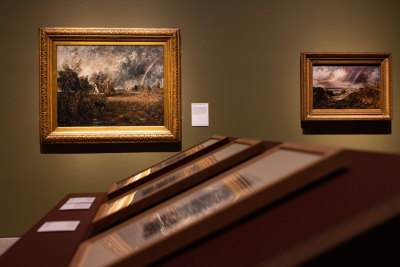Object of the month: October 2014
Object of the month: October 2014
William Pink, 'Smugglerius', c. 1834
By the RA Collection team
Published 1 October 2014
Originally cast in 1776 from the corpse of a smuggler fresh from execution, ‘Smugglerius’ was commissioned to improve the teaching of anatomy in the RA Schools.
-
Dr William Hunter, first Professor of Anatomy at the Royal Academy Schools, often performed dissections for the students, but in order to avoid this time-consuming practise he expanded the teaching collection of anatomical casts. He therefore commissioned the sculptor Agostino Carlini RA to cast the corpse of a muscular smuggler fresh from the gallows. In order to invest the gruesome business with a sense of high art, the flayed figure was posed as the Roman statue the Dying Gaul and given the pseudo-classical title Smugglerius. The original cast was made in 1776, and this present cast is a replica made in 1834 by William Pink.
-

William Pink, Smugglerius, ca. 1834.
Part of the RA CollectionPlaster cast. 755 mm. © Photo: Royal Academy of Arts, London. Photographer: Paul Highnam.
-
On its arrival at the Royal Academy, the body was flayed by William Hunter but it was believed to be the Italian sculptor Carlini who determined the pose which directly imitates that of the Dying Gaul. Hunter was fundamentally committed to empirical observation and it was this that led him to question the value of drawing from static plaster casts. It is possible therefore that the overtly classicising and less visceral appearance of this écorché, or flayed, cast was due to Carlini’s adherence to Reynolds’s theories on the relationship between nature and the Antique. While Reynolds officially approved of anatomical training for students, he insisted that artists should study from Greek and Roman statues in order to be able to ‘correct’ individual quirks and generalise towards the Ideal.
Recent attempts to establish the identity of the man who became Smugglerius have sparked some debate. The key piece of evidence is a letter from the young art student John Deare to his father dated 1 May 1776. He wrote that “I have seen two men hanged, and one with his breast cut open at Surgeons’ Hall. The other being a fine subject, they took him to the Royal Academy, and covered him with plaster of Paris, after they had put him in the position of the Dying Gladiator”.
There were only two double executions at Tyburn in London during the spring of 1776, that of Samuel Whitlow and James Langar on 12 April and of Benjamin Harley and Thomas Henman on 27 May. It is possible that Langar as the most likely candidate because the date of his execution preceded that of Deare’s letter and, as a soldier, he was more likely to have had an impressive physique than Whitlow, a servant. However, Professor Tim Hitchcock has argued that Harley and Henman should not be ruled out because it was quite usual in the eighteenth century to finish letters some weeks after starting them. Additionally Harley and Henman’s sentences specified that they were to be dissected after execution and that they were smugglers turned murderers, a widely reported fact which would explain the écorché’s fanciful nickname.
This cast is currently on loan to the exhibition Vesalius: Imagining the Body at the Museum Leuven, Belgium until 18 January 2015. Find out more about the sculpture and explore the RA Collection.




